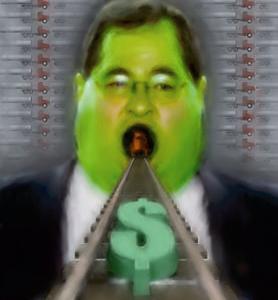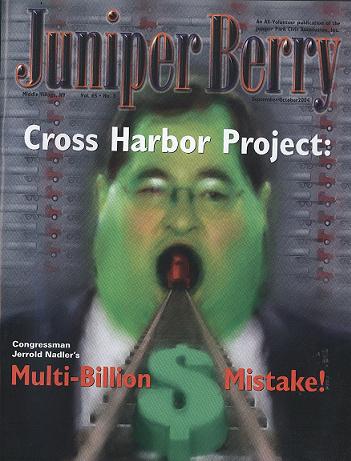But will anyone use it?
The question that the City, State and Federal “Fathers” should be asking is, “Do railroads need to cross the harbor?” The answer is, “They don't!” So why has Congressman Jerrold Nadler (D, Manhattan) been promoting the $9 Billion (that’s billion with a “b”) Cross Harbor tunnel project for years? Like the fable, “The Emperor’s New Clothes,” railroad men around him have essentially been acting like “yes men” telling Nadler what he wants to hear on the project. If you corner a railroad man he may just tell you what he really thinks of the project. Collectively they feel this project was a white elephant from the start and most felt that it would go nowhere. However railroads are vying for federal programs and dollars and Representative Nadler wields a lot of money and power on Congress’s Transportation Committee.
The “sit back and wait and see” attitude of the railroads has now given way to alarm. With the Cross Harbor tunnel momentum now growing with help and support from influential politicians like Senator Chuck Shumer, Senator Hilliary Clinton and Mayor Michael Bloomberg, this white elephant now has teeth. And residents of New York City, particularly living in Queens, Brooklyn and Long Island better take notice.
Anyone who thinks it is necessary for railroads to cross from New Jersey to New York for efficiency, growth or any other reason is simply mistaken. The idea that having a tunnel, bridge or float operation will increase rail traffic into Queens, Brooklyn and Long Island is absolutely ludicrous. If it so essential to cross the harbor for efficiency, why is there a huge, time sensitive container train that runs out of the Bronx, up the east side of the Hudson, back down the west side and then to interchange with Norfolk Southern in Hagerstown on a daily basis? If the float is such a good idea and would save so much time and money, why isn't it being used for this move? Because it is just as fast and cheap to run up and then back down the Hudson for southern traffic. In addition, CSX runs numerous trains on a daily basis, out of New Jersey via Selkirk to points west.
The billions of dollars it would cost to put in a tunnel, an improved ferry service or a bridge would be a waste of time and money and would never begin to pay for itself. The money should be spent building the intermodal terminal and docks on the Brooklyn side, (which would have to be done under any scenario); then trains would travel up the east side to Selkirk and beyond. This plan would save billions of dollars and be more feasible.
A route south out of New York to make a waterfront operation in Brooklyn feasible, is not necessary. Only 10% of the goods for the New York region on rail comes from the south. It would be easier, more efficient and cheaper to go north to the CSXT interchange that gives access to anywhere in the country and it could start tomorrow. Furthermore, why is it assumed that a tunnel to the Brooklyn waterfront, would come up at the Brooklyn waterfront? Depending on how deep the tunnel has to be to get under the channel, the opening could come up two or more miles from the waterfront. But under no circumstances would it come up at the waterfront area.
What should happen is the existing rail system should be improved and utilized to facilitate the freight needs of the region. The region could maximize the efficiency of the existing rail plant and increase its usage by effecting these simple initiatives:
1. Any freight to or from the Brooklyn waterfront would travel the New York & Atlantic (NYA) Railway Bay Ridge line and interchange with CSXT at Fresh Pond Junction. From there freight could travel anywhere in the US.
2. When the Brooklyn waterfront intermodal facility is complete, the intermodal trains would be made up there and depart over NYA to Oak Point for a crew change with CSXT or CP and on to Selkirk. This would compare with the current expedited service now being provided by CSX up the west side of the Hudson.
3. Any rail freight coming up from the south would travel up and back down the Hudson to or from the Fresh Pond interchange.
4. Inspect the tracks (i.e. clearance and weight restriction) down the East Side of the Hudson and on geographic Long Island, and make the necessary upgrades to facilitate the larger cars that are used down the west side of the Hudson and into NJ now. This would have to be done under any scenario, because there is no place to go with the excessive height or weight cars without these upgrades.
5. Build a medium size intermodal/transload facility on Long Island.
If these steps were taken, there would be jobs created for the reconstruction of the docks, jobs created for the upgrade of the tracks and jobs created to accommodate the new rail served businesses. With an efficient and economical rail system in place, trucks will be taken off the road reducing congestion and air pollution. In addition it won't take fifteen years to accomplish.
This would be simply an easier, cheaper, more efficient, quicker, cost effective and sensible way to be rebuild the rail freight in Brooklyn, Queens and Long Island. It's time we put some reason and thought into the regional transportation problems instead of just throwing money at them.
“As proposed, the Cross Harbor Project will be a blight on the town of Maspeth, and the Boroughs of Queens and Brooklyn. We will do everything possible to protect our town and its quality of life. The money could be better spent for improving education, infrastructure, senior and youth services and police and fire protection, said Anthony Nunziato, Chairman of Community Board 5’s Environmental Committee and a resident of Maspeth.




